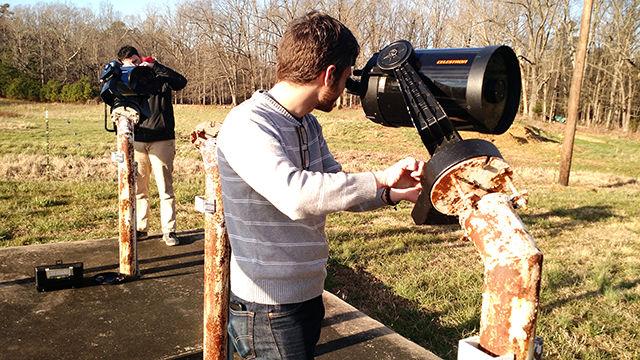Last April, NC State’s campus was taken over with celestial fever at the prospect of seeing a “blood moon,” a phenomenon in which the moon passes into the shadow of the Earth during a total lunar eclipse, bathing the moon in a red glow. In Talley Student Union, the Brickyard and the Court of North Carolina, students craned their necks for a chance to spot the rare occurrence. What they may not have known is that, several times a year, students at NC State host events to view not just the moon, but planets, stars and galaxies farther than the eye can see.
Graduate students Charles Stapleford and Sam Flynn, both studying physics, have been running stargazing events since last September using telescopes and equipment borrowed from the university. These events happen at a variety of locations in or around Raleigh, and they are open to the public. Depending on the weather and time of year, students who attend have a chance to see distant planets, galaxies, star clusters and, yes, a closer look at the moon.
Stapleford and Flynn are members of the NC State Astrophysics group, a collection of students and professors dedicated to astrophysics research and the teaching of undergraduate astronomy and astrophysics courses. They are running one-star sightseeing event tonight, Thursday, July 14, at 8 p.m., at the Falls Lake Recreation Area.
Flynn said he hopes that Jupiter, Saturn, Mars and Venus are all visible tonight but that he thinks they might miss Venus. According to Flynn, the summer humidity makes certain objects harder to see because it affects a telescope’s optics. He said the winter is better for stargazing because it is dryer.
“You’ve always got the trade off,” Stapleford said. “You either go in the summer when everybody’s comfortable being out, or you go in the winter when it’s freezing, but seeing is great.”
Humidity is not the only thing that affects stargazing. Using a program he designed, Stapleford can track important data needed in order to find the right window to view different points of interest. Time of year, sunset, sunrise, moonrise and what phase the moon is in all affect how visible different astral objects are.
“Any object that we are interested in looking at we can plug into this thing [the program] and it will tell us when it’s up,” Stapleford said. You can set out a range of dates and look for which date is going to be best.”
Flynn and Stapleford said that the events themselves are pretty simple. The two set up telescopes for the public to use, help people find objects in the sky and then answer any questions people might have. Flynn and Stapleford said that the moon is always a popular subject, especially with children.
“Kids really love the moon,” Flynn said. “You can see the planets, but they are little pinpricks. The moon is something different.”
In addition to events held periodically throughout the year, an open house event sponsored by the physics department occurs once a semester. These events are held at the NCSU Astronomy Lab Site, located off of Reedy Creek Road in Raleigh, and include physics demos presented by Keith Heyward, an associate professor of physics.
The events take a look at much farther away as well, including the Andromeda galaxy, the closest galaxy to the Earth’s at a measly 2.5 million light years away. The telescopes most commonly used at events are 8-inch diameter Schmidt-Cassegrain manual telescopes. Flynn said that the telescopes are a good fit for the events due to their wide fields of vision and mostly clear picture.
In addition to the 8-inch models, NC State’s Department of Physics also recently obtained two 6-inch automated telescopes that can find and track objects of interest in the sky using a smartphone. The auto-tracking is important because the telescopes are typically zoomed in so far that an object like a planet will actually move out of frame over time. This is due in part to the rotation of the Earth, something automated telescopes take into account and adjust for. The telescopes were purchased by the university due to the popularity of the stargazing events, according to Flynn.
Thursday’s event at the Falls Lake Recreation Center will feature four telescopes, two of which will have iPhone mounts allowing phones to take pictures through the telescope. More information can be found on the NC State Astrophysics Group’s open house page, including event listings and more detailed location information. An event is being planned for September with further details and an exact date coming soon.
A version of this article appeared in print on July 14, 2016 on page 7 with the headline, “Group spreads ‘celestial fever.'”








